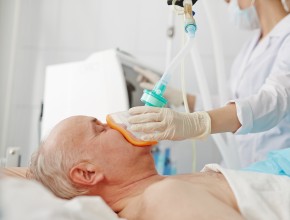VTE prophylaxis after hip or knee arthroplasty: aspirin vs rivaroxaban
Following hip or knee arthroplasty, extended use of acetylsalicylic acid (ASA) following a 5-day course of 10 mg of rivaroxaban is as effective as prolonged use of rivaroxaban.
The role of ASA in venous thromboembolism (VTE) prophylaxis following hip or knee arthroplasty is not clear. In this multicenter randomized controlled trial, all 3424 patients received 5 days of rivaroxaban (10 mg daily), following which some continued rivaroxaban and some received ASA (81 mg daily) for an additional 9 days after total knee arthroplasty or 30 days after total hip arthroplasty.
Over a period of 90 days, postoperative symptomatic VTE developed in 11 patients in the ASA group and 12 patients in the extended rivaroxaban use group (0.64% vs 0.70%). Major bleeding occurred in 8 patients in the ASA group versus 5 patients in the rivaroxaban group (0.47% vs 0.29%) and clinically important bleeding in 22 versus 17 patients (1.29% vs 0.99%), respectively. All comparisons were not statistically significant.
The authors conclude that extending VTE prophylaxis beyond 5 days of rivaroxaban use is associated with similar effects for both ASA and prolonged prophylaxis with rivaroxaban.
Postoperative opioid use in opioid-naive patients
In this retrospective cohort study, the duration of postoperative opioid use was associated with a marked increase in opioid misuse (opioid dependence, abuse, or overdose). The dose of prescribed drugs had a smaller effect, which became obvious only with longer-term use.
Data of over 1 million patients who were described as opioid-naive (not using opioids for ≥7 days in the preceding 60 days) and underwent surgery were analyzed to identify factors associated with postsurgical opioid misuse. The adjusted analysis took into account not only number of prescriptions, duration of use, and daily dose but included also age, sex, year, geographic area of residence, surgery type, and concurrent benzodiazepine use.
Following surgery, 56.0% of patients filled a prescription for an opioid. Misuse of opioids was identified in 0.2% of patients during the first year after surgery and in 0.6% during the long-term follow-up (183 cases per 100,000 person-years). The rate of opioid misuse increased from 183 per 100,000 person-years in year 2009 to 269 per 100,000 person-years in 2014. The median duration of opioid use was about 5 days with the median dose equivalent to 50 mg of morphine per day, but the trend was towards longer duration with relatively smaller doses. The overall rate of misuse was low but increased rapidly among those with a second prescription (from 145 per 100,000 person-years among those with one prescription to 293 per 100,000 person-years among those with 2 prescriptions). Each additional prescription for opioids was associated with the risk of misuse increased by 70.7% (44.0% after adjustments for additional factors), while each additional week of opioid use was associated with the risk of misuse increased by 34.2% (19.9% after adjustment). In contrast, small to moderate doses of opioids had a smaller effect: Each additional amount equivalent to 10 mg of morphine per day was associated with an increase in the probability of misuse by 0.8%. The influence of dose was major only with opioid use >9 weeks. Factors predicting opioid misuse were also use of benzodiazepines (hazard ratio [HR], 1.77), hydromorphone (HR, 1.76), or oxycodone (HR, 1.24); bariatric surgery (HR, 2.19); tobacco use (HR, 2.16); chronic pain (HR, 2.02); and depression (HR, 1.60).
While considering the potential for unaccounted confounders (factors independently influencing subsequent opioid misuse) inherent in a retrospective cohort study, the authors conclude that although short-term use of even moderately high doses of opioids carries only a small risk of future opioid misuse, the risk increases rapidly with each week of continuing prescription. The absolute dose of opioids has a smaller effect unless opioids are used for several weeks.
The authors suggest that optimal postoperative prescribing may be achieved by providing appropriate full analgesia over shorter periods (a management strategy opposite to the observed trend).
BMI and cardiovascular consequences
Being overweight (body mass index [BMI], 25.0-29.9), obese (BMI, 30.0-39.9), or morbidly obese (BMI, ≥40) has serious cardiovascular consequences.
Using a prospective cohort study analysis, the authors followed up >190,000 adults without evidence of cardiovascular disease (CVD) at baseline, providing 3.2 million person-years of observation. The analysis was adjusted for age, race or ethnic background, and smoking status. Compared with normal-weight individuals, the risk of CVD was higher with increasing BMI: Hazard ratio (HR) was around 1.27 among those overweight, 1.76 among obese, and >2.5 among morbidly obese. The greatest risk increase was observed for the development of heart failure.
The overall survival time among men was similar in the normal and overweight BMI groups (approximately 29 years) but shorter in the obese (27.2 years) and morbidly obese (23.4 years) groups. Among women, the corresponding times were 33.2, 31.8, 29.8, and 27.2 years. Morbid obesity was associated with CVD developing >7 years earlier compared with normal-weight individuals. Men and women with normal weight lived longer than their counterparts with morbid obesity (by 5.6 and 2.0 years, respectively).
The authors conclude that any type of weight above normal is associated with increased CVD-related morbidity, similar or shorter duration of life, and lower number of years lived without CVD.
 English
English
 Español
Español
 українська
українська






